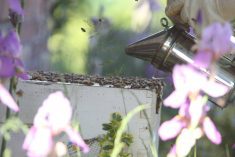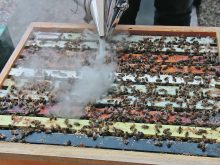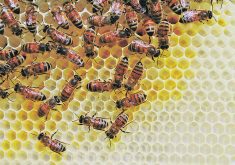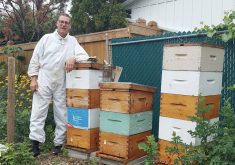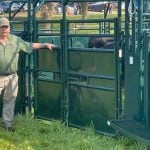Queens are now allowed from the United States, but Canadian producers want packaged honeybees included as well
A Nova Scotia beekeeper says it’s time to allow packaged honeybees from the United States into Canada.
John C. Hamilton, the apiary manager for wild blueberry producer Oxford Frozen Foods Ltd., said the Canadian industry can’t supply enough replacement stock and Eastern Canada’s wild blueberry industry is being held back.
Canada already imports queens from the U.S. and packaged bees from other countries such as Australia.
Hamilton told the standing agriculture committee, which was studying bee mortality, that in 1986, as a commercial beekeeper in Saskatchewan, he voted in favour of closing the U.S. border to prevent foreign pests from entering Canadian hives.
Read Also

How a cycling theory can help ranchers boost profits
By focusing on relatively simple, small changes, farmers and ranchers can see big results
“There are people who believe that beekeepers should build a new industry to supply our own replacement stock,” he said. “We’ve had over 30 years to accomplish this. The border closed in 1987. It hasn’t come about…This is a non-tariff trade barrier.”
He asked the committee for a science-based review of importing honeybee packages from northern California to fill a need for reasonably priced colonies and provide enough pollinators.
Conservative agriculture shadow minister John Barlow said a letter sent to the federal agriculture minister a year ago asking for a reassessment of imported hives has not been answered. He asked Hamilton why now is the right time to begin imports.
Hamilton said because all the “monsters” have come anyway, including tracheal mites, varroa mites and hive beetles.
He said Africanized honey bees haven’t moved north because American producers are figuring out how to deal with that problem.
Jake Berg, chair of the Canadian Honey Council, said domestic supply hasn’t been held back by one specific thing.
“It’s the development of that supply system and getting some of the larger pollinators to accept the fact that there could be a domestic supply,” he said.
In Saskatchewan, where he operates, the province is nearly self-sufficient, he said.
Both Berg and Hamilton said there is interest in establishing a North American bee strategy to address both imports and domestic supplies. Hamilton said the provinces would have to agree to the idea too.
Canadian beekeepers suffered severe colony losses in the winter of 2021-22 when, across the country, about 45 percent died. That is second only to the highest recorded loss in 2008.
Berg said it was too early to tell what would happen this spring.
But he noted that the multibillion-dollar canola industry relies on 60,000 to 80,000 colonies each year to pollinate seed canola in southern Alberta and Saskatchewan. More than 100,000 colonies are required to pollinate blueberries and cranberries in Eastern Canada and another 30,000 colonies pollinate high-bush blueberries in British Columbia.
“We know we are short colonies that are dedicated to pollination and there’s an ongoing discussion as to how short we really are,” he said.
Last year, the federal government established an industry-government honeybee sustainability working group and Berg said acting on the priority recommendations would help address mortality issues.
The honey council has proposed the federal government spend $150,000 annually to fund a tech transfer team in each province or region. These teams would help beekeepers identify issues, conduct applied research and be a resource.
The second priority is to speed up development of new varroa control products.
“Beekeepers know that it’s only a matter of time before Apivar loses efficacy and currently there is no replacement available,” he said.
The other two priorities are to support increased domestic stock production and address import challenges.
Tom Rosser, assistant deputy minister, market and industry services branch of Agriculture Canada, said the group has developed a plan that will be shared with federal, provincial and territorial ministers in July.
Hamilton added that getting bees from the U.S. would better serve Canadian beekeepers because the bees are spring bees. Bees coming from the southern hemisphere are going into winter and require a generational change before they work.
In another meeting, Alberta beekeeper Ron Greidanus said he too would like the border open. He said the last risk assessment was in 2013 and history is now on the beekeepers’ side






